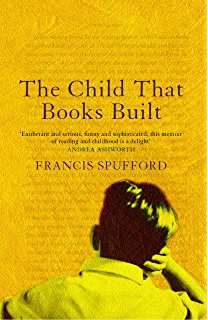 The Child That Books Built (2002) isn’t just a merry walk down memory lane. Francis Spufford was just three years old when he was joined in the world by a baby sister, Bridget, who, by a freak of nature, was terminally afflicted by cystinosis, an exceedingly rare disease resulting from her parents’ matched genetic coding.
The Child That Books Built (2002) isn’t just a merry walk down memory lane. Francis Spufford was just three years old when he was joined in the world by a baby sister, Bridget, who, by a freak of nature, was terminally afflicted by cystinosis, an exceedingly rare disease resulting from her parents’ matched genetic coding.
While his parents’ energies were concentrated to save Bridget’s life, young Spufford, confronted by what he refers to as the “fragility” of the world, retreated into a secure world of make-believe, of fictional stories. And so begins detailed reminiscences through 1960s children’s literature (Peter Dickinson, Alan Garner, Jill Paton Walsh, Penelope Farmer, Leon Garfield) as well as praise of favorites like Sendak’s Wild Things, Carroll’s Wonderland, Tolkien’s Shire, and Narnia, a particular Spufford favorite.
Books can be a retreat from Reality and Sufford’s tour of the books that meant the most to him during this difficult time is compelling. GRADE: B+
TABLE OF CONTENTS:
1 Confessions of an English Fiction Eater p. 1
2 The Forest p. 23
3 The Island p. 64
4 The Town p. 108
5 The Hole p. 149
Acknowledgments p. 211
Fast-forward 20+ years and consider Francis Sufford’s latest novel, Cahokia Jazz (2023), set in a 1920s America in a different time-line. Alternate history crime novels need time to develop their worlds so Cahokia Jazz lurches slowly into action with a murder on top of a skyscraper. Typical hard-boiled beginning.
But what if the smallpox virus that was imported to the Americas by Europeans during the “Age of Discovery” had been a milder variant of that virus — one that merely sickened the Indigenous population, rather than decimating it? (Historians estimate that up to 95 percent of Native Americans died of European diseases, chiefly smallpox.) What if, in this alternate reality, the country that came into being was one where Indigenous people were a force that wielded political power?
Cahokia Jazz features Cahokia Police Detective Joe Barrow who occupies the brooding moral center of this twisted story. Barrow is the man who leads readers through the maze of this mystery and makes us care about who is generating — and profiting from — all this chaos.
Like every hard-boiled detective who’s ever walked the mean streets of pulp fiction, Barrow is both within and without the criminal world. Burrow’s a cop who yearns to throw his badge away and play jazz piano.
If you’re in the mood for an alternate history murder mystery, Cahokia Jazz hold plenty of secrets to keep you involved to the very last page. GRADE: B
TABLE OF CONTENTS:
1 Confessions of an English Fiction Eater p. 1
2 The Forest p. 23
3 The Island p. 64
4 The Town p. 108
5 The Hole p. 149
Acknowledgments p. 211
Both books look interesting. Especially the first.
Patti, Francis Sufford is an underrated writer.
I agree. Never heard of cystinosis.
Jeff, Cystinosis is a rare genetic disorder that causes the amino acid cystine to build up in cells, leading to the formation of crystals that can damage cells and cause problems in many organs and tissues. The kidneys and eyes are the two organs most often affected.
I’m not familiar with this author but “The Child That Books Built” sounds compelling. I’ve always been curious about sixties children’s authors because (and I could be completely wrong here) it’s always seemed to me to be the turning point towards modern kids fiction. I’ll keep my eyes open for this.
I’m iffy on alternative history but this one does at least sound way more original than the usual “what if the South won the Civil War” / “what if the Nazis won WW II.” It also sounds like it could have been an expensive streaming fantasy series from a few years ago when Netflix and Amazon were firing canons full of money into the air.
I take it things didn’t end well for the sister.
Byron, there’s sadness in THE CHILD THAT BOOKS BUILT. I think today’s children’s books are very commercial. There’s pressure to make everything a “series.” I read a lot of Robert A. Heinlein and Andre Norton Young Adult SF novels in the early 1960s. Loved them!
A friend of mine’s wife writes YA books and was recently asked by her publisher to help sales by adding gay or trans characters. That’s va big selling market now.
Steve, a lot of those YA books with gay and/or trans characters are being banned in Florida. But, maybe that’s working to get people to buy them!
Well, there was no lack of Serious Themes in the likes of JOHNNY TREMAIN by Esther Forbes (1943) or THE DOOR IN THE WALL by Marguerite de Angeli (1949), which come to mind among the excellent pre-’60s YA fiction/Newbery Winners…though the DeSantises of the world were already ready to start smiting even more of the work available by the ’60s (Esther Forbes’s 1963 THE LONER was one of my absolute favorite books, and all the asinine bluenoses would’ve hated it, even as a contemporary western of the time dealing with sheep ranchers).
TREMAIN is Way the hell more grim and “adult” than the Disney film. Surprise! WW2 and the Depression had had their influences, I can imagine. TIME FOR THE STARS put me off Heinlein’s Juveniles, but, say, Silverberg’s HAWKSBILL STATION and the adult fiction of the likes of everyone were more interesting, anyway.
And, of course, the growing power of the Cherokee was what led that sorry bastard Andrew Jackson to begin his most sustained slaughter…and he’s still on the 20.